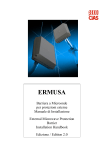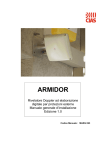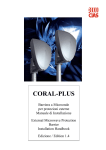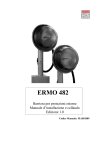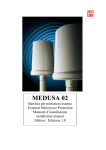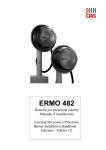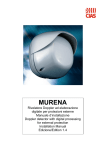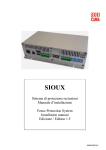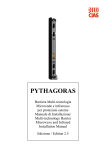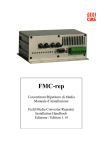Download ERMO 482
Transcript
ERMO 482 Barriera a Microonde per protezioni interne ed esterne Manuale di Installazione Internal and external Microwave protection Barrier Installation Handbook Edizione / Edition 2.2 © CIAS Elettronica S.r.l. Ed. 2.2 INDICE 1. DESCRIZIONE.......................................................................................................................................................................3 1.1 DESCRIZIONE .......................................................................................................................................................................3 1.2 SCHEMA A BLOCCHI .............................................................................................................................................................4 2. INSTALLAZIONE..................................................................................................................................................................5 2.1 2.2 2.3 2.4 2.5 2.6 INFORMAZIONI PRELIMINARI ................................................................................................................................................5 NUMERO DI TRATTE ............................................................................................................................................................6 CONDIZIONI DEL TERRENO ..................................................................................................................................................7 PRESENZA DI OSTACOLI .......................................................................................................................................................7 AMPIEZZA DEI FASCI SENSIBILI ...........................................................................................................................................8 LUNGHEZZA DELLE ZONE MORTE IN PROSSIMITÀ DEGLI APPARATI .....................................................................................9 3. COLLEGAMENTI ...............................................................................................................................................................10 3.1 MORSETTIERE, CONNETTORI E FUNZIONALITÀ DEI CIRCUITI .............................................................................................10 3.1.1 Circuito Trasmettitore ..............................................................................................................................................10 3.1.2 Circuito Ricevitore....................................................................................................................................................12 3.2 COLLEGAMENTO ALL’ALIMENTAZIONE PRINCIPALE .........................................................................................................14 3.2.1 Collegamento all’Alimentazione ..............................................................................................................................14 3.2.2 Collegamento all’Alimentazione di Riserva .............................................................................................................14 3.3 COLLEGAMENTO ALLA CENTRALE .....................................................................................................................................15 3.3.1 Contatti di allarme: Allarme, Manomissione ...........................................................................................................15 4. ALLINEAMENTO E VERIFICA .......................................................................................................................................16 4.1 ALLINEAMENTO E VERIFICA CON STRUMENTO STC 95 .....................................................................................................16 4.1.1 Operazioni sul Trasmettitore....................................................................................................................................17 4.1.2 Operazioni sul Ricevitore .........................................................................................................................................18 5. MANUTENZIONE E ASSISTENZA..................................................................................................................................22 5.1 RICERCA GUASTI ...............................................................................................................................................................22 5.2 KIT ASSISTENZA ...............................................................................................................................................................22 6. CARATTERISTICHE..........................................................................................................................................................23 6.1 CARATTERISTICHE TECNICHE ............................................................................................................................................23 Manuale di Installazione Pagina 1 di 43 ERMO 482 © CIAS Elettronica S.r.l. Ed. 2.2 INDEX 1. DESCRIPTION .....................................................................................................................................................................24 1.1 DESCRIPTION .....................................................................................................................................................................24 1.2 BLOCK DIAGRAM ...............................................................................................................................................................25 2. INSTALLATION ..................................................................................................................................................................26 2.1 2.2 2.3 2.4 2.5 2.6 PRELIMINARY INFORMATIONS ...........................................................................................................................................26 NUMBER OF SECTIONS .......................................................................................................................................................27 GROUND CONDITIONS ........................................................................................................................................................28 PRESENCE OF OBSTACLES ..................................................................................................................................................28 AMPLITUDE OF THE SENSITIVE BEAM ................................................................................................................................29 LENGTH OF THE DEAD ZONES NEAR THE EQUIPMENT ........................................................................................................30 3. CONNECTIONS ...................................................................................................................................................................31 3.1 TERMINAL BLOCKS, CONNECTORS AND CIRCUITS FUNCTIONS ..........................................................................................31 3.1.1 Transmitter Circuit ...................................................................................................................................................31 3.1.2 Receiver Circuit ........................................................................................................................................................33 3.2 EQUIPMENT CONNECTION TO THE POWER SUPPLY ............................................................................................................35 3.2.1 Connection to the Power Supply...............................................................................................................................35 3.2.2 Connection of stand-by Battery ................................................................................................................................35 3.3 CONNECTION TO THE CONTROL PANEL..............................................................................................................................36 3.3.1 Alarm contacts: Alarm, Tamper ...............................................................................................................................36 4. ADJUSTMENT AND TESTING.........................................................................................................................................37 4.1 ADJUSTMENT AND TESTING WITH STC 95 INSTRUMENT....................................................................................................37 4.1.1 Transmitter Setting-up ..............................................................................................................................................38 4.1.2 Receiver Setting-up...................................................................................................................................................39 5. MAINTENANCE AND ASSISTANCE ..............................................................................................................................42 5.1 TROUBLESHOOTING ...........................................................................................................................................................42 5.2 MAINTENANCE KITS...........................................................................................................................................................42 6. CHARACTERISTICS ..........................................................................................................................................................43 6.1 TECHNICAL CHARACTERISTICS ...........................................................................................................................................43 Manuale di Installazione Pagina 2 di 43 ERMO 482 © CIAS Elettronica S.r.l. Ed. 2.2 1. DESCRIZIONE 1.1 Descrizione ERMO 482 è la barriera a microonde di CIAS per protezione volumetrica interna ed esterna. Il suddetto sistema è in grado di rilevare la presenza di un corpo che si muove all’interno di un campo sensibile instauratosi tra il Trasmettitore (TX) e il Ricevitore (RX). Ermo 482 è disponibile con le seguenti portate: - ERMO ERMO ERMO ERMO 482 / 50 482 / 80 482 / 120 482 / 200 Manuale di Installazione Portata 50 metri Portata 80 metri Portata 120 metri Portata 200 metri Pagina 3 di 43 ERMO 482 © CIAS Elettronica S.r.l. Ed. 2.2 1.2 Schema a Blocchi Negli schemi a blocchi che seguono sono rappresentati i gruppi funzionali del circuito Trasmettitore e del circuito Ricevitore della barriera Ermo 482. Schema a Blocchi circuito Trasmettitore Ermo 482 Schema a Blocchi circuito Ricevitore Ermo 482 Manuale di Installazione Pagina 4 di 43 ERMO 482 © CIAS Elettronica S.r.l. Ed. 2.2 2. INSTALLAZIONE 2.1 Informazioni preliminari Nella figura sotto riportata è indicato un rivelatore Ermo 482 completo di accessori: palo ( diviso in tronchetti ), scatola di derivazione, ganasce e radiale per ancoraggio al terreno. . Manuale di Installazione Pagina 5 di 43 ERMO 482 © CIAS Elettronica S.r.l. Ed. 2.2 2.2 Numero di Tratte Dovendo progettare la protezione con barriere volumetriche di un perimetro chiuso, oltre alle normali considerazioni di suddivisione del perimetro in un certo numero di tratte che tengano conto delle necessità gestionali dell'intero impianto, occorre ricordare che è sempre preferibile installare un numero di tratte pari. Questa considerazione è legata al fatto che le possibili interferenze reciproche, tra tratte contigue vengono annullate nel caso in cui ai vertici (Incroci) del poligono risultante dall’installazione stessa, vengano installati due rivelatori aventi lo stesso nome, cioè due trasmettitori o due ricevitori. E' evidente che ciò può avvenire solo nel caso che il numero delle tratte sia pari. Qualora non fosse possibile disporne in numero pari, occorrerà fare alcune attente considerazioni sulle possibili interferenze in modo che possa essere correttamente scelto il vertice più opportuno dove collocare il Trasmettitore vicino al Ricevitore, alcuni esempi sono illustrati in figura 1. ERRATO CORRETTO CORRETTO ERRATO CORRETTO CORRETTO Figura 1 Manuale di Installazione Pagina 6 di 43 ERMO 482 © CIAS Elettronica S.r.l. Ed. 2.2 2.3 Condizioni del Terreno E' sconsigliabile installare gli apparati lungo tratti dove vi sono: erba alta (maggiore di 10 cm), stagni, corsi d'acqua in senso longitudinale ed in generale tutti quei tipi di terreni la cui conformazione sia rapidamente variabile. 2.4 Presenza di Ostacoli Le recinzioni se metalliche e pertanto molto riflettenti, possono causare diversi problemi di riflessione della microonda, è quindi necessario adottare alcuni accorgimenti: - la recinzione deve essere accuratamente fissata, in modo che il vento non ne provochi il movimento; - dove possibile la tratta non deve essere installata in parallelo alla recinzione, è necessario creare un angolo rispetto ad essa; - nel caso in cui il fascio sensibile debba essere delimitato lateralmente da due reti metalliche, il corridoio tra esse non deve essere inferiore ai 5 m. in quanto il loro movimento potrebbe creare dei disturbi; - recinzioni metalliche poste dietro gli apparati possono provocare talvolta distorsioni del fascio sensibile e quindi dare luogo a zone di ipersensibilità. Gli alberi, le siepi, i cespugli, la vegetazione in genere richiede una grande attenzione qualora ve ne sia in prossimità o entro i fasci di protezione. Questi ostacoli sono elementi variabili sia come dimensione che come posizione, possono infatti crescere ed essere mossi dal vento. Figura 2 Pertanto è sconsigliabile tollerare la presenza di detti ostacoli entro le tratte di protezione. E’ possibile tollerarne la presenza solo a patto che la loro crescita venga limitata mediante una metodica manutenzione e che il loro movimento venga impedito mediante barriere di contenimento. All’interno del fascio di protezione, è altresì tollerabile la presenza di tubi, pali ed Ostacoli vari (illuminazione, camini, ecc) purché non presentino dimensioni eccessive all’interno dei lobi di protezione. Questi infatti sono la causa di Zone d’Ombra non protette e di Zone di Ipersensibilità, fonti di falsi allarmi. Manuale di Installazione Pagina 7 di 43 ERMO 482 © CIAS Elettronica S.r.l. Ed. 2.2 2.5 Ampiezza dei Fasci Sensibili L'ampiezza del Campo Sensibile è in funzione sia del tipo di antenna impiegata, sia della distanza tra Trasmettitore e Ricevitore, sia dalla regolazione di sensibilità impostata. Le figure seguenti ci forniscono il diametro a metà tratta del Fascio Sensibile, in funzione della lunghezza della tratta, nel caso di sensibilità massima e minima per i diversi modelli di apparecchio impiegati. Diametro a metà tratta (m) Sensibilità massima Sensibilità minima lunghezza della tratta (m) Figura 3 - Diametro della zona sensibile a metà tratta, in spazio libero, per ERMO 482/ 50 Diametro a metà tratta (m) Sensibilità massima Sensibilità minima Lunghezza della tratta (m) Figura 4 - Diametro della zona sensibile a metà tratta, in spazio libero, per ERMO 482/ 80120-200 Nota: è necessario ricordare che per l’apparato ERMO 482 la regolazione di Sensibilità deve essere presa in considerazione per ricavare la dimensione dei fasci sensibili a metà della tratta. Quanto più alta è la soglia tanto più bassa è la sensibilità e viceversa. Manuale di Installazione Pagina 8 di 43 ERMO 482 © CIAS Elettronica S.r.l. Ed. 2.2 2.6 Lunghezza delle Zone Morte in prossimità degli apparati La lunghezza delle Zone Morte in prossimità degli apparati è in funzione sia della distanza dell'apparato stesso dal suolo, sia della sensibilità impostata sul Ricevitore, sia del tipo di antenna impiegata (figure 5-6). L’Altezza consigliata per installazioni standard è di 80 cm circa, compatibilmente con le esigenze impiantistiche. La misura è da considerarsi tra il suolo e il centro dell'apparecchio; con una sensibilità media la distanza minima consigliata per effettuare l’Incrocio è di 5 m per le barriere da 80-120-200 m e di 3,5 m per le barriere da 50 m Alte zza d a l S uo lo d e g li A p pa ra t i (c m ) Se n sibilit à M ass im a Se n sibilit à M in im a Lung h ezza de lla Z on a M or ta ( m ) Figura 5 - Lunghezza della zona morta in prossimità degli apparati in funzione dell’altezza dal centro degli stessi al suolo per ERMO 482/. 50 Altezza dal suolo degli apparati (cm) Sensibilità massima Sensibilità minima Lunghezza della zona morta (m) 80-85 cm Figura 6 - Lunghezza della zona morta in prossimità degli apparati in funzione dell’altezza dal centro degli stessi al suolo per ERMO 482/. 80-120-200 5M Figura 7 - Sovrapposizione di due fasci sensibili in un incrocio Manuale di Installazione Pagina 9 di 43 ERMO 482 © CIAS Elettronica S.r.l. Ed. 2.2 3. COLLEGAMENTI 3.1 Morsettiere, connettori e Funzionalità dei Circuiti 3.1.1 Circuito Trasmettitore 4 3 21 MS1 8 765 4 3 21 Ampolla Tamper DS1 1 2 3 4 OFF Fusibile Connettore di misura Selettore Canali ON F1 Led Rete Connettore MW TX Faston Rosso Al Positivo di Batteria Figura 8 Disposizione topografica dei componenti nel circuito Tx Nelle seguenti tabelle sono indicate le funzioni delle morsettiere, connettori, selettori e trimmer presenti sulla scheda ERMO 482 TX: MORSETTIERA MS1 TRASMETTITORE Mors. Simbolo Funzione Ingresso tensione di alimentazione alternata 19 V~ 1 ~ Ingresso tensione di alimentazione alternata 19 V~ 2 ~ 3 4 5 6 7 8 +13,8 +13,8 PR PR Manuale di Installazione Uscita negativo di alimentazione ( 0 V ) Uscita negativo di alimentazione ( 0 V ) Uscita ausiliaria di alimentazione 13,8 V Uscita ausiliaria di alimentazione 13,8 V Contatto di Manomissione (NC) + Ampolla Contatto di Manomissione (C) + Ampolla Pagina 10 di 43 ERMO 482 © CIAS Elettronica S.r.l. Ed. 2.2 CONNETTORE DI MISURA PER STC 95 Mors. Simbolo 13,8 1 2 S 3 +9 4 TRASMETTITORE Funzione Tensione di alimentazione 13,8 V Negativo della tensione di alimentazione ( 0 V ) Segnale funzionamento Oscillatore ( 4,5 V ) Alimentazione interna 9 V LEDS DEL TRASMETTITORE N° 1 Simbolo Funzione RETE Indicazione Presenza Rete Default ON SELETTORE CANALI DEL TRASMETTITORE N° 1 Simbolo Funzione DS1 Selezione dei Canali di Modulazione ( 1 ÷ 4 ) FUSIBILI DEL TRASMETTITORE N° 1 Simbolo Funzione F1 Fusibile di protezione per batteria (T2A L 250V ritardato) Manuale di Installazione Pagina 11 di 43 ERMO 482 © CIAS Elettronica S.r.l. Ed. 2.2 3.1.2 Circuito Ricevitore MS1 10 9 8 7 6 5 4 3 2 1 4 3 21 OFF SEN. INT. Tamper ON DS1 Selettore canali Ampolla Led Led Canale Allarme Regolazione Regolazione di Integrazione di Sensibilità 0.2 Vpp 1 2 Connettore 3 di 4 5 misura 6 7 Fusibile F1 5V 9V RX Led Rete Connettore MW Rag Faston Rosso Al Positivo di Batteria Figura 9 Disposizione topografica dei componenti nel circuito Rx Nelle seguenti tabelle sono indicate le funzioni delle morsettiere, connettori, selettori e trimmer presenti sulla scheda ERMO 482 TX: MORSETTIERA MS1 - RX Mors 1 2 3 4 5 6 7 8 9 10 Simbolo ~ ~ +13,8 NC C C PR PR Manuale di Installazione Funzione Ingresso tensione di alimentazione alternata 19 V~ Ingresso tensione di alimentazione alternata 19 V~ Uscita ausiliaria negativo di alimentazione ( 0 V ) Uscita ausiliaria negativo di alimentazione ( 0 V ) Uscita ausiliaria di alimentazione 13,8 V Contatto Relè di Allarme (NC) Contatto Relè di Allarme (C) Contatto Relè di Allarme (C) Contatto di Manomissione (NC) + Ampolla Contatto di Manomissione (C) + Ampolla Pagina 12 di 43 ERMO 482 © CIAS Elettronica S.r.l. Ed. 2.2 CONNETTORE DI MISURA PER STC 95 Mors 1 2 3 4 5 Simbolo S ALL S 0,2 6 + - 7 RAG RICEVITORE Funzione Soglia di Allarme ( 0,3 V ÷ 9 V ) Segnale di barriera in Allarme Segnale rivelato normalmente 0 V Verifica segnale amplificato ( 200 mVpp ) Tensione di alimentazione 13,8 V Negativo della tensione di alimentazione ( 0 V ) Tensione Regolatore Automatico di Guadagno LEDS DEL RICEVITORE N° 1 2 3 Simbolo Funzione CAN Indica il riconoscimento del canale Tx ALL Indica Allarme RETE Indica se il dispositivo è alimentato con 19 V~ Default ON ON ON TRIMMERS DEL RICEVITORE N° 1 2 Simbolo SEN INT Funzione Regolazione della Sensibilità (minima in senso antiorario) Regolazione dell’Integrazione (minima in senso antiorario) SELETTORE SELETTORE CANALI CANALI DEL RICEVITORE - RX N° 1 Simbolo Funzione DS1 Selezione dei Canali di Modulazione (1 ÷ 4) FUSIBILI DEL RICEVITORE N° 1 Simbolo Funzione F1 Fusibile di protezione per batteria (T2A L 250V ritardato) Manuale di Installazione Pagina 13 di 43 ERMO 482 © CIAS Elettronica S.r.l. Ed. 2.2 3.2 Collegamento all’Alimentazione Principale Gli apparati pur funzionando perfettamente in Corrente Continua a 13,8 V , è preferibile che siano alimentati in corrente Alternata alla tensione di 19 V~. 3.2.1 Collegamento all’Alimentazione Il collegamento tra il trasformatore e la rete a 230 V~ dovrà essere effettuato con conduttori la cui sezione sia di almeno 1,5 mm². Il cavo che porta l’alimentazione dal trasformatore all’apparecchiatura deve risultare il più breve possibile, deve essere schermato e lo schermo deve essere collegato a terra. I due conduttori devono essere collegati ai morsetti 1 e 2 della morsettiera MS1 del circuito Rx, e ai morsetti 1 e 2 della morsettiera MS1 del circuito Tx. Il trasformatore da utilizzare deve avere le seguenti caratteristiche: • tensione primaria: 230 V~ • tensione secondaria: 19 V~ • potenza minima: 30 VA NB: Utilizzare esclusivamente trasformatori di sicurezza certificati secondo le norme vigenti, ad esempio EN 60950. Deve essere assicurato un ottimo collegamento a terra della carcassa del trasformatore. Il collegamento del trasformatore alla rete 230 V~ deve essere effettuato attraverso un idoneo dispositivo di sezionamento che abbia le seguenti caratteristiche: • bipolare con distanza minima tra i contatti di 3 mm • previsto nell’impianto fisso • facilmente accessibile In ogni caso occorre attenersi scrupolosamente alle prescrizioni contenute nelle leggi e nelle normative vigenti in materia di installazioni fisse di apparati collegati permanentemente alla rete di alimentazione come la Legge 46/90 e la Normativa CEI 64-8. 3.2.2 Collegamento all’Alimentazione di Riserva All’interno di ciascuna testa è previsto lo spazio per alloggiare una Batteria ricaricabile al piombo da 12 V - 1.9 Ah (opzionale) . La batteria è normalmente ricaricata dall’alimentatore interno. Il Fusibile di protezione, contro i sovraccarichi e/o la inversione della batteria, F1 è del tipo ritardato con una portata di 2A (T2A) Questa batteria, in condizioni d’assenza rete, consente un’autonomia di circa 12 ore. NB Gli involucri delle batterie tampone utilizzate, devono avere una classe di autoestinguenza HB o migliore ( Standard UL 94 ). Manuale di Installazione Pagina 14 di 43 ERMO 482 © CIAS Elettronica S.r.l. Ed. 2.2 3.3 Collegamento alla Centrale Le connessioni alla Centrale di elaborazione devono essere effettuate mediante cavi schermati. 3.3.1 Contatti di allarme: Allarme, Manomissione Le uscite degli apparati sono costituite da Relè con contatti normalmente chiusi liberi da potenziale per la segnalazione degli stati di allarme, manomissione e guasto. Il contatto d’uscita per l’Allarme è costituito da un Relè statico con portata 100 mA max e presenta ai morsetti una resistenza complessiva di 35 Ohm. L’uscita di Manomissione è data dal contatto del Microinterruttore e dal contatto dell’Ampolla antisposizionamento, con portata 100 mA max. Le uscite sono attivate per i seguenti motivi: Uscita di Allarme 1 – Allarme intrusione sul Ricevitore 2 – Allarme canale sul Ricevitore Uscita di Manomissione 1 – Apertura della testa a microonde Tx o Rx 2 – Sposizionamento (apertura ampolla) Tx o Rx Nelle protezioni ad Alto Rischio è indispensabile che i rivelatori siano sottoposti con adeguata periodicità al Test Operativo. In questo modo la centrale di allarme sarà in grado di riconoscere i tentativi di elusione. Per effettuare il Test operativo della barriera Ermo 482 utilizzare l’accessorio Ermo-Test o disalimentare il trasmettitore. Manuale di Installazione Pagina 15 di 43 ERMO 482 © CIAS Elettronica S.r.l. Ed. 2.2 4. ALLINEAMENTO E VERIFICA 4.1 Allineamento e Verifica con Strumento STC 95 Per l’allineamento e la taratura delle proprie barriere, CIAS ha realizzato uno strumento che facilita tali operazioni ed è quindi un valido supporto per gli installatori. Di seguito è rappresentato lo Strumento STC 95 con il significato delle funzioni. Nella fig. 11 è riportato lo schema d’interconnessione dello Strumento STC 95 alle barriere ERMO 482 CIAS. Figura 10 1 2 3 4 5 6 7 Connettore 3M Display LCD Barra a LED LED misura alimentazione 13,8 Vcc LED misura campo rilevato LED misura Sens.RX / Modulazione TX LED misura Rag 13 14 15 16 17 18 19 8 9 LED misura alimentazione TX 9 Vcc LED misura alimentazione RX 5 Vcc 20 21 10 Tasto selezione misure 22 11 Tasto aumento manuale del guadagno 23 12 Tasto diminuz.manuale del guadagno Manuale di Installazione Tasto aumento soglia intervento Buzzer Tasto diminuzione soglia intervento Tasto attivazione/disattivazione Buzzer LED segnalazione buzzer attivato Tasto apertura/chiusura Loop LED segnalazione Loop aperto Tasto attivazione/disattivazione misure modulo Medusa Rx/Tx 2 LED segnalazione misure modulo Medusa Tx/Rx 2 Tasto attivazione/disattivazione misure modulo MEDUSA RX/TX-ERMO-ERMUSA-MINERMO LED segnalazione misure modulo MEDUSA RX/TX ERMO-ERMUSA-MINERMO Connettore RCA per connettere mediante il cavetto fornito l’oscilloscopio Pagina 16 di 43 ERMO 482 © CIAS Elettronica S.r.l. Ed. 2.2 Connessioni dello strumento STC 95 con le barriere ERMO 482 CIAS Figura 11 4.1.1 Operazioni sul Trasmettitore Per effettuare la taratura e il collaudo del Trasmettitore ERMO 482 occorre procedere nel seguente modo: 1. togliere la calotta di policarbonato ( Radome ) svitando le apposite viti; 2. verificare la connessione dei fili di alimentazione (19 V~) alla morsettiera MS1, connettere i faston alla batteria rispettando la polarità ( filo rosso al positivo e filo nero al negativo ) Attenzione: l’eventuale inversione di polarità della batteria provoca l’interruzione del fusibile (F1). Posizionando correttamente i “faston” e sostituendo il fusibile interrotto (T2A) l’apparecchiatura funzionerà regolarmente. 3. verificare l’accensione del led Rete con alimentazione alternata presente; 4. predisporre, agendo sul selettore canali DS1, una delle 4 frequenze disponibili ( f1,f2,f3,f4 ) spostando in posizione “ON”, esclusivamente la levetta corrispondente (le altre devono restare in posizione “OFF”). Manuale di Installazione Pagina 17 di 43 ERMO 482 © CIAS Elettronica S.r.l. Ed. 2.2 5. Effettuare l’interconnessione tra lo strumento STC 95 e la barriera ERMO 482 TX, come indicato in figura 11, inserendo il connettore a 4 pin nel “connettore di misura” del circuito. a) Verificare che il led ”Rx/Tx 1” (22) sia acceso. Qualora fosse spento premere il tasto “1” (21) per accenderlo. b) Premere il tasto ”c” (10) tante volte quante ne servono per accendere il led “+ 13,8 V” (4). La tensione letta sul display (2) dovrà essere 13,8 V ± 10 %. c) Premere il tasto ”c” (10) fino alla accensione del led “9V Tx” (8). La tensione letta sul display (2) dovrà essere 9 V ± 10 %. d) Premere il tasto ”c” (10) fino alla accensione del led “sens Rx Tx” (6). La tensione letta sul display (2) dovrà essere 4,5 V ± 10 %. 4.1.2 Operazioni sul Ricevitore Per effettuare la taratura e il collaudo del Ricevitore ERMO 482 occorre procedere nel seguente modo: 1. togliere la calotta plastica ( Radome ) svitando le apposite viti; 2. verificare la connessione dei fili di alimentazione (19 V~) alla morsettiera MS1, connettere i faston alla batteria rispettando la polarità ( filo rosso al positivo e filo nero al negativo ); Attenzione: l’eventuale inversione di polarità della batteria provoca l’interruzione del fusibile (F1). Posizionando correttamente i “faston” e sostituendo il fusibile interrotto (T2A) l’apparecchiatura funzionerà regolarmente. 3. verificare che si accenda il led Rete (con alimentazione presente); 4. predisporre, agendo sul selettore canali, lo stesso canale impostato sulla testa trasmittente, posizionando in “ON” la corrispondente levetta (le altre devono restare in posizione “OFF”) (figura 9). 5. effettuare la interconnessione tra lo strumento STC 95 e la barriera ERMO 482 RX, inserendo il connettore a 7 pin nel “connettore di misura” presente sul circuito ricevitore come indicato in figura 11. a) Verificare che il led “Rx/Tx 1” (22) sia acceso. Qualora fosse spento premere il tasto “1” (21) per accenderlo. b) Premere il tasto ”c” (10) fino ad accendere il led “+ 13,8 V “ (4). La tensione letta sul display (2) dovrà essere 13,8 V ± 10 %. Portarsi sulla parte posteriore della testa ricevente ed accertarsi che la tratta sia libera da ostacoli in movimento Se il preventivo puntamento a vista degli apparati è stato eseguito si deve verificare sul Ricevitore l’accensione dei led “CAN” e “ALL” relativi al riconoscimento del canale ed all’indicazione di non allarme (figura 9). Allo scopo di ottimizzare il collegamento, si procede all’effettuazione del puntamento elettronico nel seguente modo. c) verificare che il led “On” (16) sia spento. Qualora fosse acceso, premere il tasto “buzzer” (15) per spegnerlo, disattivando in tal modo il buzzer interno al STC 95. d) Verificare che il led “open” (18) sia acceso. Qualora fosse spento, premere il tasto “Loop” (17) per accenderlo, ottenendo in tale modo l’apertura del “LOOP”. Manuale di Installazione Pagina 18 di 43 ERMO 482 © CIAS Elettronica S.r.l. Ed. 2.2 e) Premere il tasto ”c” (10) fino ad ottenere l’accensione del led “field Rx” (5). Verificare che sul display sia leggibile una tensione di circa 6 V ± 10 % e sulla barra a led (3) sia acceso il led centrale. Qualora il valore di tensione fosse molto diverso e il led illuminato fosse verso i limiti estremi, premere il tasto “gain ⇑” (11) o il tasto “gain ⇓” (12) fino a quando si verificherà la condizione precedentemente descritta (accensione led centrale della barra e indicazione di 6 V ± 10 % sul display). f) Dopo aver allentato le viti di fissaggio sul palo, ruotare il ricevitore sul piano orizzontale fino ad ottenere la massima lettura possibile sul display (2). g) Ripetere l’operazione di puntamento agendo sulla regolazione orizzontale della testa trasmittente. h) Ottenuto il migliore puntamento, bloccare il movimento orizzontale sulle due teste. i) Sbloccare il movimento verticale della testa ricevente e orientarla verso l’alto. Spostarla lentamente verso il basso fino ad ottenere la massima lettura sul display (2) e sulla barra a led (3) con le stesse modalità adottate per la regolazione orizzontale. j) Ripetere il movimento verticale sulla testa TX e, ottenuta la massima lettura, bloccare il movimento verticale sulle due teste (TX e RX). k) Premere il pulsante “loop” (17) e verificare lo spegnimento del led “open” (18). Verificare che a Loop chiuso, dopo un tempo di recupero massimo di due minuti primi, il valore letto del “field Rx” sul display (2) si porti a 6 V . ± 10 % e si illumini il led centrale della barra. La precisione del valore assoluto ( 6 V ).di questa lettura non è molto importante essa infatti non dipende dal valore assoluto del segnale a MW ricevuto, ma bensì dalla taratura dello strumento di misura STC 95. La stabilità di questa lettura è direttamente collegata alla Stabilità del segnale MW ricevuto, pertanto una lettura instabile sta ad indicare che il segnale ricevuto è perturbato, occorre quindi accertare che non vi siano nel campo di protezione, oggetti in movimento, o che il segnale ricevuto sia insufficiente e quindi affetto da rumore. In caso di dubbio, verificare la reale situazione utilizzando un oscilloscopio collegato al connettore RCA dell’STC 95 (vedi punto S). l) Premere il tasto ”c” (10) fino ad ottenere l’accensione del led “Vrag Rx” (7) e verificare sul display che la tensione letta sia compresa tra 2,5 ÷ 6,5 V . Questo valore di RAG è direttamente proporzionale alla distanza tra testa trasmittente e ricevente. Se il valore di Rag letto raggiunge valori superiori a 6 V significa che il segnale sul ricevitore è molto basso e quindi il collegamento è precario m) Premere il tasto ”c” (10) fino ad ottenere l’accensione del led “sens RxTx” (6). Agire sul trimmer SEN ( Sensibilità) fino a leggere sul display un valore compreso tra 0,3 ÷ 9 V ± 10 %. Va tenuto presente che il valore di 0,3 V corrisponde alla massima sensibilità e il valore 9 V corrisponde alla minima sensibilità. Le prove di attraversamento vengono di norma, effettuate da una persona che cammina in posizione eretta ad una velocità di 0.5 m/s. Si consiglia di iniziare le prove con una impostazione del 50 % di sensibilità (corsa del trimmer) ed una regolazione del 40 % di integrazione (corsa del trimmer). La regolazione di sensibilità deve essere effettuata per soddisfare le esigenze di protezione dello specifico sito. Manuale di Installazione Pagina 19 di 43 ERMO 482 © CIAS Elettronica S.r.l. Ed. 2.2 Una Sensibilità troppo elevata può causare allarmi impropri. Si consiglia di non adottare sensibilità maggiori del 75 % (corsa del trimmer) che corrisponde a circa 1,6 V . Una Sensibilità troppo bassa può impedire la rivelazione di un intruso di dimensioni ridotte. Si consiglia di non adottare sensibilità inferiori al 25 % (corsa del trimmer) che corrisponde a circa 6,7 V . n) Regolare il trimmer INT (figura 9) fino ad ottenere l’Integrazione desiderata (massima in senso orario). L’Integrazione agisce sulla Velocità di attraversamento. Le prove di attraversamento vengono di norma effettuate da una persona che cammina in posizione eretta ad una velocità di 0.5 m/s. La regolazione di integrazione deve essere effettuata per soddisfare le esigenze di protezione dello specifico sito. Una regolazione di Integrazione eccessivamente bassa può causare allarmi impropri. Si consiglia di non adottare un’integrazione superiore al 80 % (corsa del trimmer). Integrazioni di valore maggiore possono essere favorevolmente adottate quando la barriera è installata in modo che l’intruso non possa attraversarla correndo (ad esempio lungo la parete di un edificio). o) Premere il tasto “buzzer” (15) verificare l’accensione del led “on” (16) che corrisponde alla abilitazione del buzzer.In assenza di movimenti nel campo di protezione verificare che il buzzer sia silenziato. Se non lo fosse, premere il tasto “buzzer adj. ⇓” (14) fino ad ottenere il suo spegnimento Se all’attivazione della funzione il buzzer fosse già silenziato, agire sul tasto “buzzer adj. ⇑” (13) fino ad ottenere il suo intervento intermittente, quindi agire leggermente sul tasto “buzzer adj. ⇓” (14) fino a silenziarlo. p) Effettuare le prove di attraversamento verificando prima il suono intermittente del buzzer e successivamente il suono continuo e lo spegnimento del led Allarme sulla barriera RX, che indica l’avvenuto rilevamento dell’allarme. q) Verificare, inoltre, che in assenza di movimento nel campo protetto il buzzer non entri in funzione. Se ciò avvenisse, anche in modo discontinuo, significa che il campo è perturbato. r) Per attraversamento di grossi bersagli può verificarsi lo spegnimento anche del led Canale indicando in tal modo che si è verificata l’interruzione del segnale RF. La taratura della barriera va effettuata tenendo presenti le esigenze dell’utente, ma ricordando che un’eccessiva sensibilità si presta alla generazione di allarmi impropri. Per questo motivo si deve ricercare, di volta in volta, il compromesso più opportuno E’ importante ricordare che l’Integrazione agisce sulla Velocità d’attraversamento, mentre la Sensibilità agisce sulla Massa. Manuale di Installazione Pagina 20 di 43 ERMO 482 © CIAS Elettronica S.r.l. Ed. 2.2 s) Lo strumento STC 95, come mostrato in fig.11 dispone di un’uscita RCA (23) che, mediante il cavetto in dotazione, consente di verificare la forma d’onda del segnale ricevuto. Tale verifica richiede un oscilloscopio (qualsiasi modello presente sul mercato). Un buon collegamento tra testa trasmittente e testa ricevente mostra una forma d’onda come indicato in figura 13. 50 mV/div. 50 mV/div. 100 us/div. Figura 13 - Forma d'onda corretta 100 us/div. Figura 14 - Forma d'onda non corretta (eccessivo rumore) A = 200 mVpp (+ 10%) Un cattivo collegamento mostra una forma d’onda come indicato in figura 14. Si osservi come sulle cuspidi dell’onda quadra sia presente il rumore. Ciò sta a significare che il segnale ricevuto non è ottimale. In questo caso ripetere le operazioni di puntamento fino ad ottenere la forma d’onda di figura 13. Tutti i dati relativi alle misure effettuate in impianto vanno riportati sulle Schede di Collaudo che sono in dotazione ad ogni barriera. Ciò renderà più semplice l’operazione di assistenza. t) Rimontare le calotte ( Radome ) in policarbonato bloccandole uniformemente con le apposite viti in modo da ottenere una buona tenuta all’acqua. Manuale di Installazione Pagina 21 di 43 ERMO 482 © CIAS Elettronica S.r.l. Ed. 2.2 5. MANUTENZIONE E ASSISTENZA 5.1 Ricerca Guasti In caso di Falsi Allarmi, verificare i parametri riscontrati durante l’Installazione che saranno stati registrati nell’apposita Scheda di Collaudo allegata e se si riscontrano delle variazioni che eccedono i limiti indicati, rivedere i relativi punti nel capitolo 4 “ Allineamento e Verifica “. Difetto Led alimentazione spento Tx e/o Rx Tensione 13,8 V o 19 V~ non corretta e/o insufficiente Led Canale spento Possibile Causa Alimentazione +19 V~ non presente Connessioni interrotte Trasformatore guasto Lunghezza e/o sezione cavi non Adeguata Selezione canale errata VRag elevato Tx o Rx guasti Movimento od ostacoli nel campo protetto Teste disallineate Teste disallineate Ostacoli nel campo protetto Segnale trasmesso insufficiente Circuito guasto Ricevitore a microonde guasto Contatto manomissione aperto Microinterruttore aperto Led Allarme spento Ampolla in posizione errata Possibile Soluzione Verifica collegamenti Effettuare connessioni Sostituire trasformatore Ridimensionare nuovamente le connessioni e/o i cavi Agendo sul selettore canali del Ricevitore impostare lo stesso canale del Trasmettitore Sostituire parti guaste Assicurarsi che non vi sia nulla nel campo protetto Effettuare il puntamento Eseguire il puntamento Rimuovere gli ostacoli Controllare il Trasmettitore Sostituire il Ricevitore Sostituire il Rilevatore a microonde Verificare la chiusura del microinterruttore Verificare la posizione dell’ampolla 5.2 Kit Assistenza I Kit di Assistenza sono costituiti dalla parte di elaborazione circuitale completi di parte a microonde. L’operazione di sostituzione è molto semplice. Un dato importante da tenere presente è che il kit d’assistenza è sempre tarato per la massima prestazione, cioè 200 metri di portata. Ciò per facilitare il compito di chi è chiamato ad effettuare l’assistenza evitandogli l’onere di disporre di 4 diversi kit in funzione delle portate. In questo modo con un solo kit d’assistenza l’installatore non ha più l’onere di acquistare delle barriere complete per l’assistenza ed inoltre rende più semplice e rapida tale operazione.La sostituzione della parte circuitale e della cavità sia sul Trasmettitore sia sul Ricevitore non altera l’orientamento della barriera e quindi non obbliga ad effettuare un nuovo puntamento. Manuale di Installazione Pagina 22 di 43 ERMO 482 © CIAS Elettronica S.r.l. Ed. 2.2 6. CARATTERISTICHE 6.1 Caratteristiche Tecniche Min CARATTERISTICHE TECNICHE Nom Max Da 9,47 GHz a 10,60 GHz In accordo con le richieste nazionali Da 20 a 500 mW e.i.r.p. In accordo con le richieste nazionali Frequenza di lavoro Potenza massima di emissione Modulazione Duty-Cycle Numero di canali PORTATE ERMO 482 / 50 ERMO 482 / 80 ERMO 482 / 120 ERMO 482 / 200 On / Off 50 / 50 4 50 m 80 m 120 m 200 m Tensione d'alimentazione ( V~ ) Tensione d'alimentazione (V ) Corrente assorbita max. TX ( mA~ ) Corrente assorbita max. RX in vigilanza ( mA~ ) Corrente assorbita max. RX in allarme ( mA~ ) Corrente assorbita max. TX ( mA ) Corrente assorbita max. RX in vigilanza ( mA Corrente assorbita max. RX in allarme ( mA Alloggiamento per batteria 17 V~ 11,5 V ) ) 19 V~ 13,8 V 158 mA 130 mA 120 mA 50 mA 38 mA 32 mA 21 V~ 14,8 V 12 V Contatto relè di allarme intrusione (RX) Contatto rimozione radome e sposiz.(RX+TX) 100 mA 100 mA 120 mA SEGNALAZIONI LUMINOSE Presenza alimentazione - led verde (TX / RX) Stato di NON Allarme – led verde (RX) Riconoscimento canale - led verde (RX) Regolazione della soglia di Sensibilità (RX) Regolazione della soglia d’Integrazione (RX) Peso senza batteria (TX) Peso senza batteria (RX) Diametro Profondità comprese le ganasce Temperatura di lavoro Livello di prestazione: Grado di protezione dell'involucro: Manuale di Installazione Note / 1,9 Ah C-NC C-NC On On On Trimmer Trimmer 2910 g 2970 g - 25 °C 3° IP 55 Pagina 23 di 43 305 mm 280 mm + 55 °C ERMO 482 © CIAS Elettronica S.r.l. Ed. 2.2 1. DESCRIPTION 1.1 Description The ERMO 482 equipment is a microwave system for outdoor / indoor volumetric barrier protection. Such a system can detect the presence of somebody or something moving within the sensitive field present between the transmitter (Tx) and the receiver (Rx). The ERMO 482 system types availabile: - ERMO 482 / 50 ERMO 482 / 80 ERMO 482 / 120 ERMO 482 / 200 Installation Handbook Range 50 meters Range 80 meters Range 120 meters Range 200 meters page 24 to 43 ERMO 482 © CIAS Elettronica S.r.l. Ed. 2.2 1.2 Block Diagram In the following diagrams are showed the functional block of the complete Ermo 482 (Transmitter and Receiver). Modulator Battery Low Freguency Generator Channel Select Ermo 482 Transmitter Block Diagram Battery Channel Select Delay Adjustment Sensitivity Adjustment Ermo 482 Receiver Block Diagram Installation Handbook page 25 to 43 ERMO 482 © CIAS Elettronica S.r.l. Ed. 2.2 2. INSTALLATION 2.1 Preliminary Informations Due to the various types of ERMO 482 barrier, there are some different kinds of installation and fixing unit types related to user requirements. The following picture show ERMO 482 device with accessories: pole segment, transformer junction box, pole bracket and anti-spin bars. Installation Handbook page 26 to 43 ERMO 482 © CIAS Elettronica S.r.l. Ed. 2.2 2.2 Number of Sections Having to design protection with volumetric barriers of a closed perimeter, besides having to split the perimeter within a certain number of sections that take into account the management need of the entire plant, it must be remembered that it is always preferable to install an even number of sections. This consideration is bound to the fact that the likely reciprocal interferences between adjacent sections are annulled should at the vertices of the polygon (cross), resulting from the installation of the various sections, be installed two equipment with the same name, two transmitters or two receivers. It is evident that this might occur only if the number of sections is even. Should it not be possible to have an even number of sections then some careful considerations must be made on interferences that might likely occur in order to find the vertex point where retained best to place the transmitter near the receiver. The following pictures show some typical cases for which the most correct solution is given. WRONG RIGHT RIGHT WRONG RIGHT RIGHT Figure 1 Installation Handbook page 27 to 43 ERMO 482 © CIAS Elettronica S.r.l. Ed. 2.2 2.3 Ground conditions It is inadvisable to install the equipment along sections with tall grass (more than 10 cm), ponds, longitudinal waterways, and all those types of grounds whose structure is rapidly mutable. 2.4 Presence of Obstacles The fences, are generally metallic therefore highly reflecting hence causing various problems, for this reasons some precautions are suggested: - first of all, make sure that the fence has been properly fixed in order that the wind does not move. - if it is possible the microwave beam shouldn’t be placed in parallel to a metallic fence, is necessary to create a corner with it. - metal fences placed behind the equipment night cause distortions to the sensitive beam especially, and might cause movement detection in unexpected spots, with subsequent likely generation of false alarms. - In case of Mw barrier should be installed in a corridor between two metallic fences, the width of the corridor should be necessary not less to 5 m. Along the section, within the area of the protection field, are allowed pipes, poles or similar (e.g., lamp posts) as long as their dimensions, with respect to the protection beam, are not too excessive. The trees, hedges, bushes in general, need very great attention if near or within the protection beams. These obstacles vary in size and position, in fact they grow and they can be moved by the wind. Therefore, it is absolutely inadvisable to tolerate the presence of the cited obstacles within the protection sections. Figure 2 It is possible to tolerate the presence of these elements near the protection sections only if their growth is limited through routine maintenance, and if their movement is stopped through containment barriers. Various Obstacles might be present along the protection sections. For them there is the need to make the same considerations and take the same necessary precautions adopted for the above cases. This cause of Dead zones not protected and Hypersensitive zones which cause false alarm. Installation Handbook page 28 to 43 ERMO 482 © CIAS Elettronica S.r.l. Ed. 2.2 2.5 Amplitude of the Sensitive Beam The amplitude of the Sensitive Beam depends on the distance between the transmitter and the receiver, and on the sensitivity adjustment set. The figures below state the diameter half-way of the sensitive beam section (based on the length of the section) in case of maximum and minimum sensitivity (figure 3 and 4). With a medium sensibility, the minimun space recomend for corner crossing is 3,5 m. For wall installation, the minimum distance from the wall to the centre head are 30 cm. Diameter Half-Way (m) Maximum Sensitivity Minimum Sensitivity Lenght of the Section (m) Figure 3 Diameter of sensitive beam at the half-section length (ERMO 482/ 50) (Free space) Diameter Half-Way (m) Maximum Sensitivity Minimum Sensitivity Lenght of the Section (m) Figure 4 Diameter of sensitive beam at the half-section length (ERMO 482/ 80-120-200) (Free space) Remark: that for the ERMO 482 equipment, the Sensitivity regulation to be considered for obtaining the dimensions of the sensitivity beams half-way of the section, is that of the alarm threshold. The higher the threshold the lower the sensitivity, and vice versa. Installation Handbook page 29 to 43 ERMO 482 © CIAS Elettronica S.r.l. Ed. 2.2 2.6 Length of the Dead Zones near the equipment The length of the Dead Zones near the equipment is based on the distance of the equipment from ground, on the sensitivity set on the receiver and on the type of antenna used. With regard to the considerations stated above, and based on plant requirements, the equipment must be installed at a certain height from ground. In mean plant the height must be 80 cm. (from the ground and the centre of the equipment). With medium sensitivity setting, the suggested crossing overlap is 5 m., for the 80-120200 m. versions and 3,5 m. for the 50 m. version. Installation Height (cm) Maximum Sensitivity Minimum Sensitivity Length of the Dead Zone Figure 5 ERMO 482 -50: Dead zone length near the equipment versus installation height. Installation Height (cm) Maximum Sensitivity Minimum Sensitivity Length of the Dead Zone (m) 80-85 cm Figure 6 ERMO 482. 80-120-200: Dead zone length near the equipment versus installation height. De 5M Installation Handbook ne D ea d Zo page 30 to 43 ad Z on e ERMO 482 © CIAS Elettronica S.r.l. Ed. 2.2 3. CONNECTIONS 3.1 Terminal Blocks, Connectors and Circuits Functions 3.1.1 Transmitter Circuit The following figure and tables show the terminal block and connector function present on the ERMO 482 TX board. 4 3 21 MS1 8 765 4 3 21 Bulb Tamper Test Connector DS1 Channel 1 2 Selector 3 4 OFF Fuse F1 Main Led ON MW Connector TX Red faston to battery positive Figure 8 Layout of connectors, jumpers, LEDs and presetting in transmitter board TRASMITTER MS1 TERMINAL BLOCK Term 1 Symbol 2 3 4 5 6 7 8 Installation Handbook ~ ~ 13,8 13,8 PR PR Function Mains Ac Power Supply input (19 V~) Mains Ac Power Supply input (19 V~) Ground connection Ground connection Dc Power Supply input (13,8 V ) Dc Power Supply input (13,8 V ) Tamper relay contact (Normally Closed) + Bulb contact Tamper relay contact ( Closed) + Bulb contact page 31 to 43 ERMO 482 © CIAS Elettronica S.r.l. Ed. 2.2 TRASMITTER TEST CONNECTOR FOR STC 95 INSTRUMENT Term Symbol Function 13,8 Power Supply 13,8 V 1 Ground 2 S Function Oscillator Signal OK ( 4,5 V 3 +9 Internal Power Supply 9 V 4 ) TRASMITTER LEDS N° 1 Symbol Function Main Main presence indication Default ON TRASMITTER CHANNELS SWITCH N° 1 Symbol Function DS1 Channel Selector ( 1 ÷ 4 ) Default TRASMITTER FUSES N° 1 Symbol Function F1 Power supply protection fuse battery 13,8 V Installation Handbook page 32 to 43 ERMO 482 © CIAS Elettronica S.r.l. Ed. 2.2 3.1.2 Receiver Circuit The following figure and tables show the terminal block and connector function present on the ERMO 482 RX board. MS1 10 9 8 7 6 5 4 3 2 1 4 3 21 OFF DS1 ON SEN. INT. Tamper Bulb Channel Alarm Led Led Channel Selector 0.2 Vpp 1 2 3 4 5 6 7 5V 9V Test Connector Fuse F1 Delay Adjustment Sensitivity Adjustment RX Main Led MW Connector Rag Red faston to battery positive Figure 9 Layout of connectors, jumpers, LED and presetting in receiver board RECEIVER MS1 TERMINAL BLOCK Term 1 Symbol 2 3 4 5 6 7 8 9 10 Installation Handbook ~ ~ 13,8 NC C C PR PR Function Mains ac Power Supply input (19 V~) Mains ac Power Supply input (19 V~) Ground connection Ground connection Power Supply positive input 13,8 V Alarm contact Relè (NC) Alarm contact Relè (C) Alarm contact Relè (C) Tamper relay contact (Normally Closed) + Bulb contact Tamper relay contact ( Closed) + Bulb contact page 33 to 43 ERMO 482 © CIAS Elettronica S.r.l. Ed. 2.2 RECEIVER TEST CONNECTOR FOR STC 95 INSTRUMENT Term Symbol Function S 1 Alarm threshold ( 0,3 ÷ 9 V ) ALL Alarm signal 2 S Detected signal 3 0,2 Amplify signal ( 200 mVpp ) 4 Power Supply Output 13,8 V 5 + 6 - 7 V Rag Ground AGC (Automatic Gain Control) Voltage RECEIVER LEDS N° 1 2 3 Symbol Channel Channel Ok Alarm Alarm Main Power On Function Default ON ON ON RECEIVER TRIMMERS N° 1 2 Symbol Function SEN Sensitivity setting Trimmer ( Minimum – anticlock wise ) INT Integration setting Trimmer ( Minimum – anticlock wise ) RECEIVER CHANNELS SWITCH N° 1 Symbol DS 1 Channel Selector ( 1 ÷ 4 ) Function RECEIVER FUSES N° 1 Symbol Function F1 Power supply protection fuse battery 13,8 V Installation Handbook page 34 to 43 ERMO 482 © CIAS Elettronica S.r.l. Ed. 2.2 3.2 Equipment Connection to the Power Supply Even if the equipment is Direct Current powered ( 13,8 V advisable to power it by Alternating Current ( 19 V~ ). ), they still operate properly, but it is 3.2.1 Connection to the Power Supply The connection between the equipment and the transformer must be as short as possible (less then 4 meters), and the section of the conductor must not be less than 1.5 mm².. The connection between the transformer and the 230 V mains will be as that of the previous one. The power supply cables connecting transformer with equipment, must be of shielded type with shield connected to ground. The connection between unit and the power supply must be realised with cables of correct section, the cables section must be computed keeping in account connection length and unit current absorption. For the power supply connection (Alternative Current ) 19V~, to make connect term 1/2 on the terminal strep MS1 of the Rx circuit and 1/2 on the terminal strep MS1 of the Tx circuit. Use only safety transformers with the following characteristics: • primary voltage: 230 V~ • secondary voltage 19 V~ • minimum power 30 VA Remark. Use only safety transformers (example Certified EN 60950) Make sure to connect the body of the transformer to hearth tap. The transformer connection to the main (230 V~), must be carried out through one circuit breaker having the following characteristics: • bipolar with minimum distance between contacts equal to 3 mm • provided in the fix part of cabling • easily accessible • However laws and standards concerning installations of devices permanently connected to the main (230 V~), must be strictly respected (in Italy law 46/90 and standard CEI 64-8). 3.2.2 Connection of stand-by Battery Into each equipment heads there is the housing for an optional rechargeable back-up lead battery (12 V – 1.9 Ah). The battery is charged by the internal power supply, through the red and black fastons and wires connected to the terminals 1 and 2 of the terminal block MS1. The provided protection fuse (against overload and/or battery polarity inversion) F1 is T2A slowblow type The back-up lead battery allows to the barrier head (TX or RX), at least 12 hours of perfect working, in case of mains missing. Remark. Package, of the optional standby battery, must have a flame class equal or better than HB (UL 94 Standard) Installation Handbook page 35 to 43 ERMO 482 © CIAS Elettronica S.r.l. Ed. 2.2 3.3 Connection to the Control Panel On transmitter and receiver PCB are present 1 relays. These Relay is static with dry contacts normally closed. By means of these contacts it’s possible to communicate to the control panel the following conditions: Alarm, Tamper 3.3.1 Alarm contacts: Alarm, Tamper The Alarm output is made by static Relays contacts with 100 mA 12 V max capability and total internal resistance of 35 Ohm. The Tamper output is made of Microswitch contact and a Bulb contact with 100 mA max capability. The outputs are activated by the following reasons: Alarm output: Tamper output: 1– 2– 1– 2– Intrusion Alarm on Receiver Channel Alarm on Receiver Opening of microwave head, Tx or Rx Changing head position (Bulb contact), Tx or Rx For high risk protection it’s necessary a Periodic Test for the equipements. By means for these control panel will be able to detect tamper action. For the Test function activation it wich have Ermo-Test strument; it’s possible to test the microwave barrier, temporary switchingoff the transmitter. Installation Handbook page 36 to 43 ERMO 482 © CIAS Elettronica S.r.l. Ed. 2.2 4. ADJUSTMENT AND TESTING 4.1 Adjustment and Testing with STC 95 Instrument For the Microwave Barrier Adjustment and Testing, CIAS gives the availability of a dedicated instrument, with the intention to facilitate installation operation and operator activity support. The following figure 10 shows the CIAS STC 95 instrument with function explanations. Figure 10 1 2 3M connector LCD Display 13 14 3 4 5 6 7 LED strip Power supply LED test 13,8 V Received field LED test Check Sens.RX / RF TX LED AGC LED check 15 16 17 18 19 8 9 Power supply LED test TX 9 V Power supply LED test RX 5 V 20 21 10 Tests selection key 22 11 Manual increasing gain key 23 12 Manual decreasing gain key Installation Handbook Increasing threshold Buzzer activation key. Decreasing threshold Buzzer activation key. Buzzer activation / deactivation key. Buzzer activation LED Open / closed Loop key Open loop LED indication Activation / deactivation tests key TX / RX 2 and Medusa Test indication LED RX / TX 2 Measurement activation / deactivation key TX / RX 1, MEDUSA, ERMO, ERMUSA, MINERMO Test indication LED TX / RX 1, MEDUSA, ERMO, ERMUSA, MINERMO RCA for scope connection with supplied cable page 37 to 43 ERMO 482 © CIAS Elettronica S.r.l. Ed. 2.2 STC 95 connections to ERMO 482 CIAS Barriers IFB Module Flat Cable ermo 482 / 583 Connector 7 pin ermo 482 RX Connector 4 pin ermo 482 TX flat STC 95 Oscilloscope RCA /BNC Cable Figure 11 4.1.1 Transmitter Setting-up To align and adjust the Transmitter ERMO 482 proceed as follows: - unscrew the specific screws to remove the front cover ( Radome ); - activate the power supply connection to MS1 terminal block; - check that the Main led indicating presence of mains lights up; - connect the “fastons” to the battery paying attention to the polarity (red lead to battery positive, black lead to battery negative); - preset one of the 4 channels available through the channel selector DS1 (figure 8). Installation Handbook page 38 to 43 ERMO 482 © CIAS Elettronica S.r.l. Ed. 2.2 Connect the STC 95 instrument to the ERMO 482 Tx barrier, use the related flat cable (16 wires) and insert it in its connector. a) Check that led Rx/Tx 1 (22) is on. If it isn’t, press the key “1” (21) for on it. b) Press the key “c” (10) a number of time as needed for on the led “+ 13,8 V” (4). The voltage indicated by display (2) must be 13,8 V + 10%. c) Press the key “c” (10) until the led “9V Tx” is on (8). The voltage indicated by display (2) must be 9 V + 10%. d) Press the key “c” (10) until the led “sens. Rx / Tx” on (6). The voltage indicated by display (2) must be 4,5 V + 10%. 4.1.2 Receiver Setting-up To align and adjust the Receiver ERMO 482 proceed as follows: - unscrew the specific screws to remove the front cover ( Radome ); - activate the power supply connection to MS1 terminal block; - check that the main Led indicating presence of mains lights up; - connect the “fastons” to the battery paying attention to the polarity (red lead to battery positive, black lead to battery negative). - preset one of the 4 channels available through the channel selector DS 1, same as channel preset on Transmitter unit. Connect the STC 95 instrument to the ERMO 482 RX barrier as shown in figure 9. Insert the seven pins connector into its connector present on Receiver circuit (fig. 9). a) Check that led “Rx / Tx 1” (22) is on If not press the key “1” (21) for on b) Press the key “c” (10) a number of time as needed for on the led “+ 13,8 V” (4). The voltage indicated by display (2) must be 13,8 V + 10%. Go on the rear part of receiver head and verifies that the path is free from moving obstacles. If the previous visual system alignment is correct, check that the CAN and ALL led are on. For the path optimisation go on with electronic alignment, see next: c) check that the led “On” (16) is off. If not, press the key “buzzer” (15), for turn the led off, this force the STC 95 internal buzzer not active. d) check that the led "open" (18) is on, if not press the key “loop” (17), for the “loop” opening and turn on the led. e) press the key “c” (10) until the led “field Rx” (5) is on. Check that a 6 V ± 10 % voltage is read on the display and that the mid led is glowing on the led (3). Should the voltage value differ and should the glowing led be the end ones, then press either key “⇑ gain” (11) or key “⇓ gain” (12), till the previously described condition arises (i.e., the led in the middle of the bar lights up, and a 6 V ± 10 % value is read on the display). f) After having loosened the fastening screws on the mast, turn the Receiver module on the horizontal plane till obtaining the maximum reading on the display (2). Installation Handbook page 39 to 43 ERMO 482 © CIAS Elettronica S.r.l. Ed. 2.2 g) Repeat the pointing operation on the horizontal adjustment of the transmitter module. h) After having obtained the best pointing, lock the horizontal movement of the TX and RX modules. i) Unlock the vertical movement of the RX module and direct it towards the top. Slowly move it towards the bottom till obtaining the maximum reading on display (2) and on the led (3) by proceeding as per the horizontal adjustment. j) Repeat the vertical movement on the TX module. After having obtained the maximum reading, lock the vertical movement on modules TX and RX. k) Press key “loop” (17) and check that Loop Closure led “open” (18) turns off; check that after a recovery period of approx. 2 mins at the Closed Loop,. the value “field Rx” read on display (2) reaches approx. 6 V ± 10 %, and that the led at the centre of the bar is on. Note: the absolute value precision of this test (6 V ) isn't very important, because it doesn't depend by the absolute value of microwave (MW) received signal, but it is related to the instrument STC 95 adjustment. On the contrary the stability of this test, is directly related to the stability of the received microwave (MW) signal, for this reason the instability of this test mean that the RF received signal is in some way perturbed, in this case is necessary to check for the absence of moving object into the protecte area, or check if the received signal is too weak and so affected by large amount of noise. In case of uncertainty check the real working condition by means of a scope connected to RCA connector of STC 95 (see point "S"). l) Press key “c” (10) till led “V Rag Rx” (7) is on. Check that a voltage value within 2,5 ÷ 6,5 V . is read on the display. This AGC voltage value is directly proportional to the distance between the transmitting and receiving heads. m) Press key “c” (10) till the Sensitivity Measurement led “sens Rx / Tx” (6) is on. Operate on the SEN trimmer present in module RX (fig. 10) till a value within 0,3 and 9 ± 5 % is read on the display. Note that the value of 0,3 V corresponds to the V maximum sensitivity, and that value 9 V corresponds to the minimum sensitivity. The alarm crossing tests usually are performed with a walking person (standing) moving at a speed of 0.5 m/s. We suggest to start this tests with the sensitivity adjusted at 50 % (trimmer position) and the integration adjusted at 40 % (trimmer position). The final sensitivity adjustment must be related to the specific site requirements. Note: Too much Sensitivity can cause unwanted alarms. We suggest to adjust the max. sensitivity at no more than 75 % (trimmer position), which correspond at about 1,6 V . Too low sensitivity can miss alarm in case of little dimension intruder. We suggest to adjust the min. sensitivity at no less than 25 % (trimmer position), which correspond at about 6,7 V . n) Adjust the INT trimmer on module RX (figure 9) till obtaining the required Integration (max clockwise). The integration function act on intruder crossing speed. The alarm crossing tests usually are performed with a walking person (standing) moving at a speed of 0.5 m/s. The final integration adjustment must be related to the specific site requirements. Installation Handbook page 40 to 43 ERMO 482 © CIAS Elettronica S.r.l. Ed. 2.2 Note: too low integration can cause unwanted alarms. We suggest to adjust the min. integration at no less than 30 % (trimmer position). Too much integration can miss alarm in case of running intruder. We suggest to adjust the max. integration at no more than 80 % (trimmer position). Higher integration value can be adopted when the barrier can't be crossed by running intruder, ( the barrier installation is along a building wall). o) Press key “buzzer” (15) untill the buzzer enabling led “buzzer On” (16) is on. When there are no movements in the protection field check that the buzzer is mute. If otherwise, press key “⇓ buzzer adj.” (14) till it turns off. If when activating the function the buzzer is already mute press key “⇑ buzzer adj.” (13) till an intermittent operation is obtained, afterwards slightly press key “⇓ buzzer adj.” (14) till it switches off. p) Carry out the crossing trials to check for the presence of an intermittent sound and then, following the presence of an alarm, for a continuous buzzer and Alarm led is off. Receiver unit (alarm for intrusion detection). q) Check that the buzzer is not active for no moving object into the protected field. If the buzzer ring (also in an intermittent manner) the protection field is in some way disturbed. r) If the protection field is crossed by a very big object, the Channel led turns off, this means an interruption of RF signal. s) The STC 95 is provided with an RCA (23) connector which, through the cable supplied, allows to check the wave form of the received signal. An oscilloscope (any of the types present on the market) is utilised for this check. A good connection between the transmitting head and the receiving head produces the waveform illustrated in fig. 13. 50 mV/div. 50 mV/div. 100 us/div. 100 us/div. Figure 13 - Correct waveform Figure 14 - not correct waveform (excessive noise) A = 200 mVpp (+ 10%) A bad installation produces the waveform illustrated in fig. 14. Note the noise at the tip of the square wave. This means that the signal is not good. Therefore, repeat the pointing operations till the waveform shown in fig. 13 is obtained. In case of bad barrier installation the waveform will be like the one in fig. 14. All the data concerning the tests made on the plant must be reported on the test sheets supplied for each barrier. This will make the servicing operations easier to carry out. t) Place the front cover cap back again and regularly fasten it with the screws provided in order to obtain good water proofing. Installation Handbook page 41 to 43 ERMO 482 © CIAS Elettronica S.r.l. Ed. 2.2 5. MAINTENANCE AND ASSISTANCE 5.1 Troubleshooting In case of false alarm, check the parameters recorded during the Installation phase (on attached Test Sheet), if there are divergences with permitted limits check again the related points in chapter "Adjustment and Testing (4)" Fault Power Supply Led Off ( Tx and / or Rx ) 13,8 V o 19 V~ not correct and / or not sufficient ( see par. 3.2.1) Channel Led Off Alarm Led Off VRag High Tamper relay Open Possible reason No Power Supply Cable disconnected Fault Transformer Length and / or cable section not proper Channel selection wrong Tx or Rx fault Movement or obstacle in the protected field Heads not aligned Heads not aligned Obstacle in the field Low transmitter signal Fault circuit MW receiver fault Micro-switch open Antiremoval bulb in wrong position ( not vertical ) Possible solution Check connection Make connection Change Transformer Modify connection and / or cable Set the same channel on Tx / Rx Change circuit Tx or Rx Ensure that nothing is in the field Remake the alignment ( see par 4.1.1 or 4.1.2 ) Do the alignment Remove obstacles Check Tx Change Rx Change MW receiver Check micro-switch Check position of antiremoval bulb 5.2 Maintenance kits The Maintenance Kits are composed by circuits equipped with microwave cavities, their substitution is very easy: The Maintenance Kits is always presetted for the maximum performance i.e. 200 m. The max. performance Kit avoids the needs of four types of Kits for the four types of barrier. By this way the maintenance people can simply operate on installations maintenance without purchase the entire barrier. Unlock the only one fixing screw and install the new circuit into related plastic guides present on the bottom box. The circuit and cavity substitution on boot transmitter and receiver heads doesn’t changes the heads alignment, and so no new alignment is required Installation Handbook page 42 to 43 ERMO 482 © CIAS Elettronica S.r.l. Ed. 2.2 6. CHARACTERISTICS 6.1 Technical characteristics TECHNICAL CHARACTERISTICS Min Frequency 9,47 GHz to 10.60 GHz According with national rules 20 to 500 mW e.i.r.p. According with national rules Maximum Power to emitting Modulation Duty-cycle Channel number RANGE: ERMO 482 / 50 ERMO 482 / 80 ERMO 482 / 120 ERMO 482 / 200 Nom Max On / Off 50 / 50 4 50 m 80 m 120 m 200 m DC Power Supply ( V~ ): 17 V~ 11,5 V DC Power Supply (V ): Max. Current absorption TX (mA ~) Max. Current absorption RX in Surveillance (mA ~) Max. Current absorption RX in Alarm (mA ~) Max. Current absorption TX (mA ) Max. Current absorption RX in Surveillance (mA ) Max. Current absorption RX in Alarm (mA ) Intrusion Alarm contact (RX) (N.C.) Radome removal contact and out of position (TX RX) 19 V~ 13,8 V 158 mA 130 mA 21 V~ 14,8 V 120 mA 50 mA 38 mA 32 mA 100 mA 100 mA 120 mA LEDS Power Supply presence (TX) Green LED Channel identification (RX) Green LED Non intrusion Alarm status (RX) Green LED Sensitivity tuning (RX) Integration tuning (RX) Weight without battery (TX) Weight without battery (RX) Diameter Depth with jaw Operating Temperature Performance Level Box Protection level Installation Handbook Note On On On Trimmer Trimmer 2910 g 2970 g - 25 °C 3° IP 55 page 43 to 43 305 mm 280 mm + 55 °C ERMO 482 SCHEDA DI COLLAUDO – TEST SHEET ERMO 482 TX NUMERO DI SERIE SERIAL NUMBER: Cliente/Customer Indirizzo/Address Barriera /Barrier N° VALORI MISURATI SUL TRASMETTITORE – MEASURED VALUES ON THE TRASMITTER MISURE MEASUREMENTS 1 2 3 TENSIONE DI ALIMENTAZIONE, MISURATA TRA I PIN 4 - 6 DI J1(PIN4 = GND). (*) SUPPLY VOLTAGE, MEASURED BETWEEN PINS 4 - 6 OF J1(PIN4 = GND). (*) TENSIONE DI ALIMENTAZIONE INTERNA MISURATA TRA IL PIN 16 DI J1 E GND (*) INSIDE SUPPLY VOLTAGE MEASURED BETWEEN PIN 16 OF J1 AND GND (*) TENSIONE OSCILLATORE FUNZIONANTE MISURATA TRA IL PIN 13 DI J1 E GND OSCILLATOR OK VOLTAGE MEASURED BETWEEN PIN 13 OF J1 AND GND 4 SELEZIONE MASTER/SLAVE (SOLO VERSIONE “S”) MASTER/SLAVE SELECTION (ONLY “S” VERSION) 5 CANALE DI MODULAZIONE SELEZIONATO MODULATION CHANNEL SELECTED (*) (*) VALORI TIPICI STANDARD VALUES VALORI MISURATI MEASURED VALUES INSTALLAZIONE INSTALLATION MANUTENZIONE MAINTENANCE □ MASTER □ SLAVE □ MASTER □ SLAVE □ Ch 1 □ Ch 2 □ Ch 3 □ Ch 4 □ Ch 1 □ Ch 2 □ Ch 3 □ Ch 4 13,8 VDC ± 10% 9 VDC ± 10% 4,5 V ± 10% - - misura può essere effettuata anche con lo strumento STC 95 It is possible to make the measure also by the STC 95 TAGLIARE QUI / CUT HERE OSSERVAZIONI DELL’INSTALLATORE – INSTALLER COMMENTS Data installazione/Installation date Firma Installatore/Installer Signature SCHEDA DI COLLAUDO – TEST SHEET ERMO 482 RX NUMERO DI SERIE SERIAL NUMBER: Cliente/Customer Indirizzo/Address Barriera /Barrier N° VALORI MISURATI SUL RICEVITORE – MEASURED VALUES ON THE RECEIVER MISURE MEASUREMENTS 1 2 3 4 5 6 (*) (*) VALORI TIPICI STANDARD VALUES TENSIONE DI ALIMENTAZIONE, MISURATA TRA I PIN 4 - 6 DI J1(PIN4 = GND). (*) SUPPLY VOLTAGE, MEASURED BETWEEN PINS 4 - 6 OF J1(PIN4 = GND). (*) 13,8 VDC ± 10% TENSIONE DI ALIMENTAZIONE INTERNA MISURATA TRA IL PIN 12 DI J1 E GND (*) INSIDE SUPPLY VOLTAGE MEASURED BETWEEN PIN 12 OF J1 AND GND (*) 5 VDC ± 10% VERIFICA SEGNALE RIVELATO, MISURATA CON LO STRUMENTO STC 95. SIGNAL DETECTED VOLTAGE MEASURED BY STC 95. 6 VDC ± 10% STABILE STEADY TENSIONE DI RAG, MISURATA TRA IL PIN 14 DI J1 E GND. (*) AGC VOLTAGE MEASURED BETWEEN PIN 14 OF J1 AND GND. (*) 2,5 ÷ 6 VDC TENSIONE DI SOGLIA MISURATO TRA IL PIN 8 DI J1 E GND.(*) THREESHOLD VOLTAGE MEASURED BETWEEN PIN 14 OF J1 AND GND. (*) 0.25 ÷ 6.5 VDC CANALE DI MODULAZIONE SELEZIONATO MODULATION CHANNEL SELECTED - VALORI MISURATI MEASURED VALUES INSTALLAZIONE INSTALLATION MANUTENZIONE MAINTENANCE □ Ch 1 □ Ch 2 □ Ch 3 □ Ch 4 □ Ch 1 □ Ch 2 □ Ch 3 □ Ch 4 misura può essere effettuata anche con lo strumento STC 95 It is possible to make the measure also by the STC 95 Data installazione/Installation date Firma Installatore/Installer Signature TAGLIARE QUI / CUT HERE OSSERVAZIONI DELL’INSTALLATORE – INSTALLER COMMENTS NOTE: Con la presente, CIAS Elettronica, dichiara che questo rivelatore di intrusione “ERMO 482” è conforme ai requisiti essenziali ed alle altre disposizioni rilevanti della Direttiva 1999/5/CE (Art.3.1a-3.1b-3.2) Hereby, CIAS Elettronica, declares that this movement detector ERMO 482” is in compliance with the essential requirement and other relevant provisions of Directive 1999/5/EC (Art.3.1a3.1b-3.2) Questo apparecchio è contrassegnato in conformità alla Direttiva Europea 2002/96/EC, Waste Electrical and Electronic Equipment (WEEE) Assicurarandosi che questo prodotto sia smaltito in modo corretto, l’utente contribuisce a prevenire le potenziali conseguenze negative per l’ambiente e la salute. Il simbolo sul prodotto o sulla documentazione d’accompagnamento indica che questo prodotto non deve essere trattato come rifiuto domestico ma deve essere consegnato presso l’idoneo punto di raccolta per il riciclaggio d’apparecchiature elettriche ed elettroniche. Disfarsene seguendo le normative locali per lo smaltimento rifiuti. Lo smaltimento abusivo è punito con le sanzioni previste dalla legislazione nazionale vigente Il prodotto può essere riconsegnato al distributore/installatore a fine vita in occasione di un nuovo acquisto. This product is marked in compliance with the European Directive 2002/96/EC, Waste Electrical and Electronic Equipment (WEEE). The correct disposal of the product will prevent potential negative consequences for the environment and the human health. on the product or into the annexed documentation indicates that this product The symbol does not have to be dealt like domestic refusal but must be delivered near the suitable point of collection for the recycling of electrical and electronic equipment. The illicit disposal will be endorsed according to local l regulations. At the end of operative life the product can be given back to the vendor/installation organization in occasion of a new purchase. © Copyright CIAS Elettronica S.r.l. Stampato in Italia / Printed in Italy CIAS Elettronica S.r.l. Direzione, Ufficio Amministrativo, Ufficio Commerciale, Laboratorio di Ricerca e Sviluppo Direction, Administrative Office, Sales Office, Laboratory of Research and Development 20158 Milano, via Durando n. 38 Tel. +39 02 376716.1 Fax +39 02 39311225 Web-site: www.cias.it E-mail: [email protected] Stabilimento / Factory 23887 Olgiate Molgora (LC), Via Don Sturzo n. 17
















































